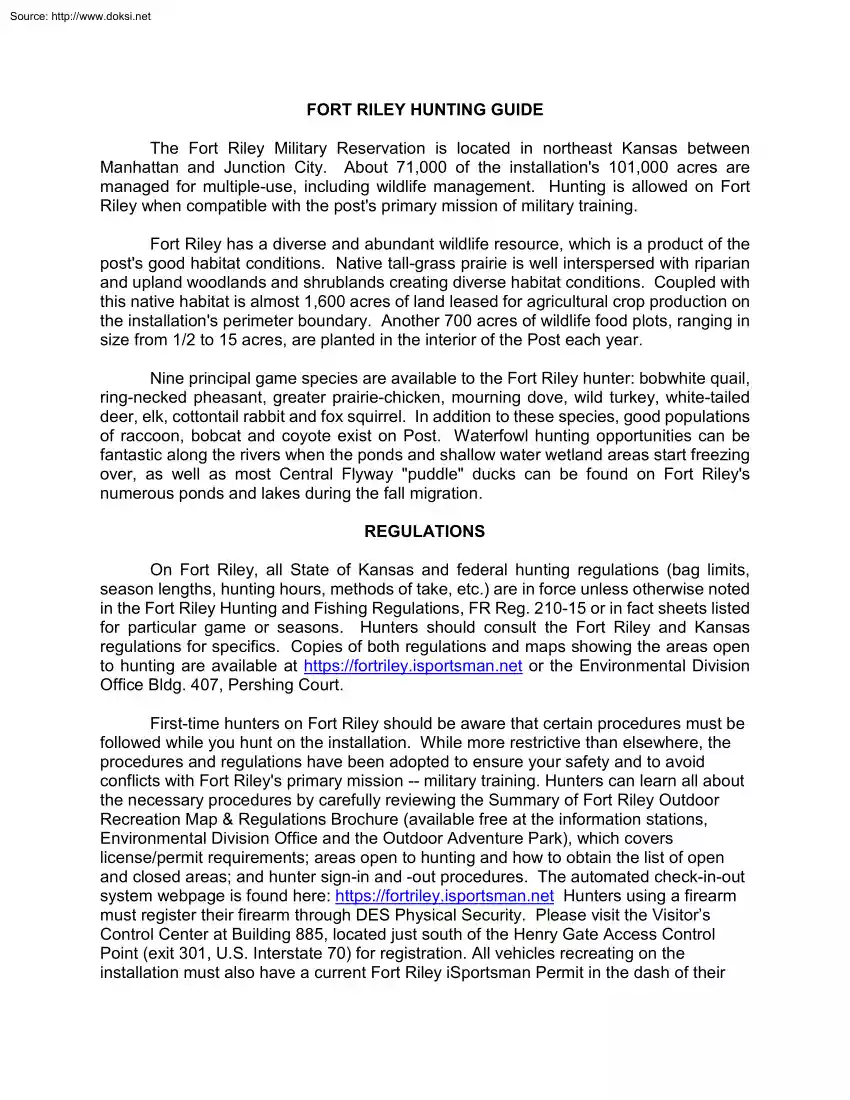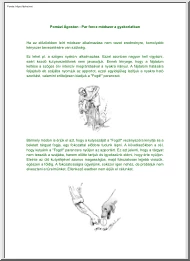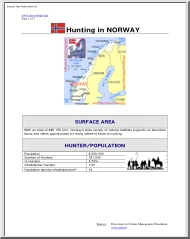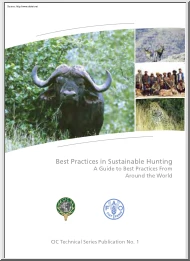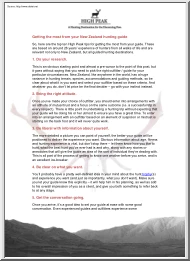Datasheet
Year, pagecount:2018, 3 page(s)
Language:English
Downloads:1
Uploaded:February 25, 2019
Size:533 KB
Institution:
-
Comments:
Attachment:-
Download in PDF:Please log in!
Comments
No comments yet. You can be the first!Content extract
Source: http://www.doksinet FORT RILEY HUNTING GUIDE The Fort Riley Military Reservation is located in northeast Kansas between Manhattan and Junction City. About 71,000 of the installations 101,000 acres are managed for multiple-use, including wildlife management. Hunting is allowed on Fort Riley when compatible with the posts primary mission of military training. Fort Riley has a diverse and abundant wildlife resource, which is a product of the posts good habitat conditions. Native tall-grass prairie is well interspersed with riparian and upland woodlands and shrublands creating diverse habitat conditions. Coupled with this native habitat is almost 1,600 acres of land leased for agricultural crop production on the installations perimeter boundary. Another 700 acres of wildlife food plots, ranging in size from 1/2 to 15 acres, are planted in the interior of the Post each year. Nine principal game species are available to the Fort Riley hunter: bobwhite quail, ring-necked pheasant,
greater prairie-chicken, mourning dove, wild turkey, white-tailed deer, elk, cottontail rabbit and fox squirrel. In addition to these species, good populations of raccoon, bobcat and coyote exist on Post. Waterfowl hunting opportunities can be fantastic along the rivers when the ponds and shallow water wetland areas start freezing over, as well as most Central Flyway "puddle" ducks can be found on Fort Rileys numerous ponds and lakes during the fall migration. REGULATIONS On Fort Riley, all State of Kansas and federal hunting regulations (bag limits, season lengths, hunting hours, methods of take, etc.) are in force unless otherwise noted in the Fort Riley Hunting and Fishing Regulations, FR Reg. 210-15 or in fact sheets listed for particular game or seasons. Hunters should consult the Fort Riley and Kansas regulations for specifics. Copies of both regulations and maps showing the areas open to hunting are available at https://fortriley.isportsmannet or the Environmental
Division Office Bldg. 407, Pershing Court First-time hunters on Fort Riley should be aware that certain procedures must be followed while you hunt on the installation. While more restrictive than elsewhere, the procedures and regulations have been adopted to ensure your safety and to avoid conflicts with Fort Rileys primary mission -- military training. Hunters can learn all about the necessary procedures by carefully reviewing the Summary of Fort Riley Outdoor Recreation Map & Regulations Brochure (available free at the information stations, Environmental Division Office and the Outdoor Adventure Park), which covers license/permit requirements; areas open to hunting and how to obtain the list of open and closed areas; and hunter sign-in and -out procedures. The automated check-in-out system webpage is found here: https://fortriley.isportsmannet Hunters using a firearm must register their firearm through DES Physical Security. Please visit the Visitor’s Control Center at Building
885, located just south of the Henry Gate Access Control Point (exit 301, U.S Interstate 70) for registration All vehicles recreating on the installation must also have a current Fort Riley iSportsman Permit in the dash of their Source: http://www.doksinet vehicle. The permits may be printed off after taking the annual safety briefing, which explains procedures for recreating on the installation. SMALL GAME MAMMALS Good populations of both eastern cottontail rabbits and fox squirrels occur on Fort Riley. Cottontails prefer brushy and grassy cover, much the same as bobwhite quail Many of the rabbits taken on Fort Riley each year are taken incidentally by quail and pheasant hunters. Rabbit populations are cyclical and may fluctuate from year-to-year. Squirrel hunters will find a stable population of fox squirrels in Fort Rileys 12,000 acres of woodland. UPLAND GAME BIRDS Bobwhite Quail Found throughout the Post, bobwhites prefer "edge" habitat -- those margins where two or
more cover types such as grassland, shrubland, woodland and cropland come together. During most of the year, including the hunting season, quail are found in small groups called coveys. Populations can fluctuate dramatically in this part of the species range depending on the severity of the previous winters. In good years, quail are abundant anywhere their habitat requirements are met. Ring-Necked Pheasant A native of Asia, the pheasant has thrived in Kansas. In recent years, it has expanded its traditional western Kansas range into the northeastern part of the state. Hunters will find ringnecks around old farmsteads, shelterbelts, weedy corners, crop areas, and slough and pond areas on post. The north half of Fort Riley generally produces the best hunting. During the winter pheasants flock together and late-season hunters may find large groups of birds where heavy cover provides shelter from the elements. Because of their tendency to run, pheasants can be difficult to hunt without a
good flushing dog and several hunting partners. Stationing one or two hunters as "blockers" at the end of the field being hunted produces the most birds in the hunters bag. Only the colorful male birds, called cocks, may be legally hunted. Greater Prairie-Chicken Kansas is the greater prairie-chickens strong-hold, due mostly to maintenance of the extensive, native tall-grass prairie habitat of the Flint Hills. Source: http://www.doksinet Prairie-chickens may be hunted during an early fall season or later in late fall and winter. During early fall, chickens may be flushed by hunters walking through grassy roosting cover. During the late fall and winter season, the best technique is to locate field of milo, soybeans, or corn and pass shoot the birds as they come to feed early and late in the day. Crop fields of 10 acres or more seem to be the preferred feeding areas Cultivated firebreaks around the boundary normally are the top chicken producing areas on post. Please read
and follow the annual Greater Prairie-Chicken Fact Sheet published by Fort Riley prior to hunting the birds on the installation. Mourning Dove Dove hunting can be good on Fort Riley. Due to its location, Fort Riley is host to large numbers of both home-grown and migratory doves during the hunting season. Post doves usually begin their migration south about the middle of September. But good hunting often continues through mid-October because migratory birds from northern states stop-over on post. OTHER SPECIES In addition to the game species already mentioned, Fort Riley offers good hunting for raccoon and coyotes. Red fox, bobcat, opossum, badger and striped skunk may also be hunted on Fort Riley during the legal season. White-tailed Deer, Spring Turkey and Trapping seasons on Fort Riley all have fact sheets detailing specific information for each of their respective seasons. Elk hunting is authorized on the installation as well, but permits must be drawn through the Kansas Department
of Wildlife, Parks & Tourism’s lottery draw. Applications are taken during the month of June and early July. For additional information please contact the Fort Riley Environmental Division at Building 407, Pershing Court or call 785-239-6211. Additional information may also be obtained through the Fort Riley iSportsman website here: https://fortriley.isportsmannet
greater prairie-chicken, mourning dove, wild turkey, white-tailed deer, elk, cottontail rabbit and fox squirrel. In addition to these species, good populations of raccoon, bobcat and coyote exist on Post. Waterfowl hunting opportunities can be fantastic along the rivers when the ponds and shallow water wetland areas start freezing over, as well as most Central Flyway "puddle" ducks can be found on Fort Rileys numerous ponds and lakes during the fall migration. REGULATIONS On Fort Riley, all State of Kansas and federal hunting regulations (bag limits, season lengths, hunting hours, methods of take, etc.) are in force unless otherwise noted in the Fort Riley Hunting and Fishing Regulations, FR Reg. 210-15 or in fact sheets listed for particular game or seasons. Hunters should consult the Fort Riley and Kansas regulations for specifics. Copies of both regulations and maps showing the areas open to hunting are available at https://fortriley.isportsmannet or the Environmental
Division Office Bldg. 407, Pershing Court First-time hunters on Fort Riley should be aware that certain procedures must be followed while you hunt on the installation. While more restrictive than elsewhere, the procedures and regulations have been adopted to ensure your safety and to avoid conflicts with Fort Rileys primary mission -- military training. Hunters can learn all about the necessary procedures by carefully reviewing the Summary of Fort Riley Outdoor Recreation Map & Regulations Brochure (available free at the information stations, Environmental Division Office and the Outdoor Adventure Park), which covers license/permit requirements; areas open to hunting and how to obtain the list of open and closed areas; and hunter sign-in and -out procedures. The automated check-in-out system webpage is found here: https://fortriley.isportsmannet Hunters using a firearm must register their firearm through DES Physical Security. Please visit the Visitor’s Control Center at Building
885, located just south of the Henry Gate Access Control Point (exit 301, U.S Interstate 70) for registration All vehicles recreating on the installation must also have a current Fort Riley iSportsman Permit in the dash of their Source: http://www.doksinet vehicle. The permits may be printed off after taking the annual safety briefing, which explains procedures for recreating on the installation. SMALL GAME MAMMALS Good populations of both eastern cottontail rabbits and fox squirrels occur on Fort Riley. Cottontails prefer brushy and grassy cover, much the same as bobwhite quail Many of the rabbits taken on Fort Riley each year are taken incidentally by quail and pheasant hunters. Rabbit populations are cyclical and may fluctuate from year-to-year. Squirrel hunters will find a stable population of fox squirrels in Fort Rileys 12,000 acres of woodland. UPLAND GAME BIRDS Bobwhite Quail Found throughout the Post, bobwhites prefer "edge" habitat -- those margins where two or
more cover types such as grassland, shrubland, woodland and cropland come together. During most of the year, including the hunting season, quail are found in small groups called coveys. Populations can fluctuate dramatically in this part of the species range depending on the severity of the previous winters. In good years, quail are abundant anywhere their habitat requirements are met. Ring-Necked Pheasant A native of Asia, the pheasant has thrived in Kansas. In recent years, it has expanded its traditional western Kansas range into the northeastern part of the state. Hunters will find ringnecks around old farmsteads, shelterbelts, weedy corners, crop areas, and slough and pond areas on post. The north half of Fort Riley generally produces the best hunting. During the winter pheasants flock together and late-season hunters may find large groups of birds where heavy cover provides shelter from the elements. Because of their tendency to run, pheasants can be difficult to hunt without a
good flushing dog and several hunting partners. Stationing one or two hunters as "blockers" at the end of the field being hunted produces the most birds in the hunters bag. Only the colorful male birds, called cocks, may be legally hunted. Greater Prairie-Chicken Kansas is the greater prairie-chickens strong-hold, due mostly to maintenance of the extensive, native tall-grass prairie habitat of the Flint Hills. Source: http://www.doksinet Prairie-chickens may be hunted during an early fall season or later in late fall and winter. During early fall, chickens may be flushed by hunters walking through grassy roosting cover. During the late fall and winter season, the best technique is to locate field of milo, soybeans, or corn and pass shoot the birds as they come to feed early and late in the day. Crop fields of 10 acres or more seem to be the preferred feeding areas Cultivated firebreaks around the boundary normally are the top chicken producing areas on post. Please read
and follow the annual Greater Prairie-Chicken Fact Sheet published by Fort Riley prior to hunting the birds on the installation. Mourning Dove Dove hunting can be good on Fort Riley. Due to its location, Fort Riley is host to large numbers of both home-grown and migratory doves during the hunting season. Post doves usually begin their migration south about the middle of September. But good hunting often continues through mid-October because migratory birds from northern states stop-over on post. OTHER SPECIES In addition to the game species already mentioned, Fort Riley offers good hunting for raccoon and coyotes. Red fox, bobcat, opossum, badger and striped skunk may also be hunted on Fort Riley during the legal season. White-tailed Deer, Spring Turkey and Trapping seasons on Fort Riley all have fact sheets detailing specific information for each of their respective seasons. Elk hunting is authorized on the installation as well, but permits must be drawn through the Kansas Department
of Wildlife, Parks & Tourism’s lottery draw. Applications are taken during the month of June and early July. For additional information please contact the Fort Riley Environmental Division at Building 407, Pershing Court or call 785-239-6211. Additional information may also be obtained through the Fort Riley iSportsman website here: https://fortriley.isportsmannet
